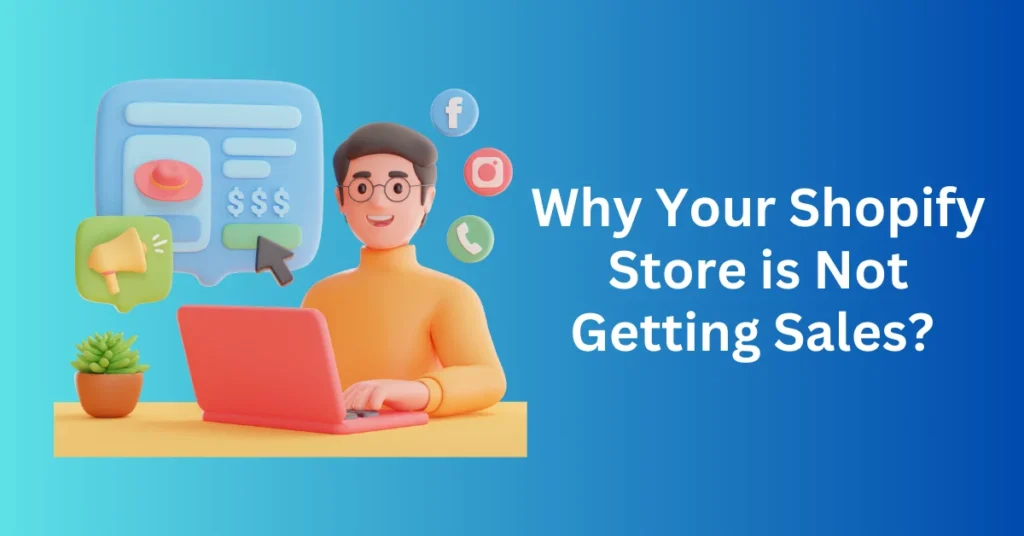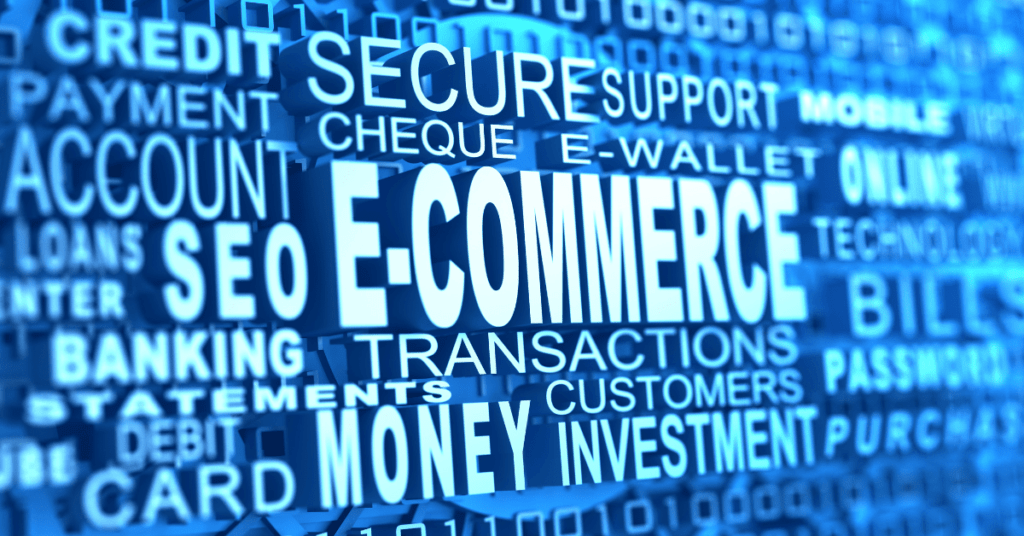Starting an online store on Shopify is indeed an exciting venture, but scaling up and increasing sales can present real challenges. Whether you’re a seasoned seller or new to the world of ecommerce, you’re likely eager to explore strategies that can help boost sales and drive growth.
In this guide, we’ll delve into the most common reasons why Shopify sellers may struggle to generate sales. Additionally, we’ll provide seven actionable tips to enhance your store’s performance, attract more customers, and ultimately drive greater sales.
Prepare to take notes as we explore these strategies and empower you to maximize the potential of your Shopify store. With the right approach and implementation, you can overcome obstacles and achieve success in the competitive world of e-commerce.
Start Your Shopify Store Today
Why Your Shopify Store is Not Getting Sales?
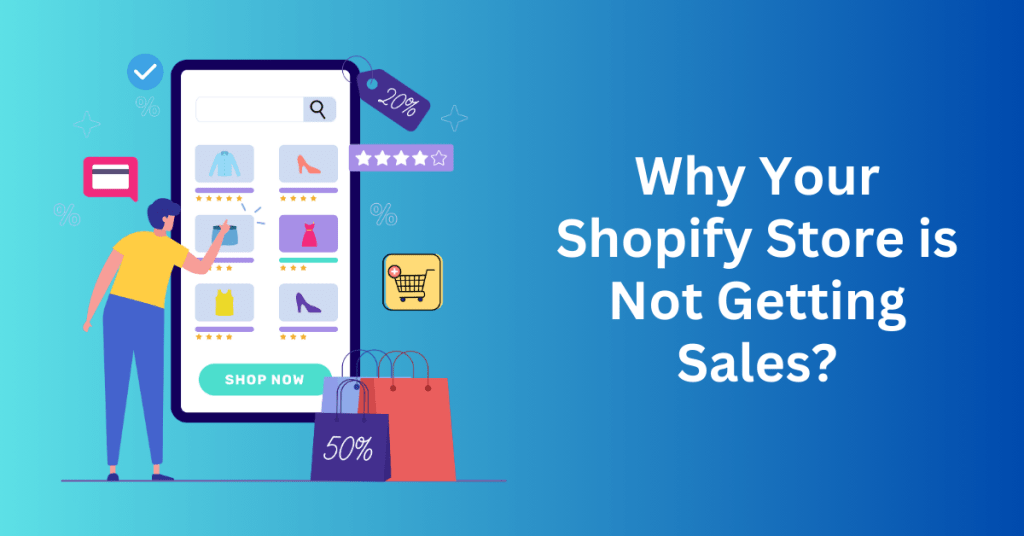
Launching a Shopify store can be an exciting venture, but it can also be disheartening when anticipated sales fail to materialize. There are numerous factors that could contribute to this. Let’s look at a few common issues.
1. Lack of Traffic
A neglected ecommerce store is a clear indication that something is wrong. If your Shopify store feels as silent as a library on a Friday night, your sales will not be soaring.
Even with amazing products, if customers can’t find you, they can’t purchase from you. Additionally, increasing traffic can be straightforward. You can enhance your store’s SEO, promote it on social media, or run ads targeting your ideal customers.
2. Poor eCommerce Store Design
A heavy, outdated, or unattractive website design can repel potential customers within seconds. In today’s visually-driven world, aesthetics play a crucial role in capturing and retaining customer interest. A poorly designed website is akin to a neglected corner store with peeling paint and a flickering neon sign—it fails to attract customers.
To remedy this, consider hiring a professional web designer or utilizing high-quality templates to craft a cohesive and visually appealing website that captivates and retains your audience’s attention.
3. Not Optimized for Mobile
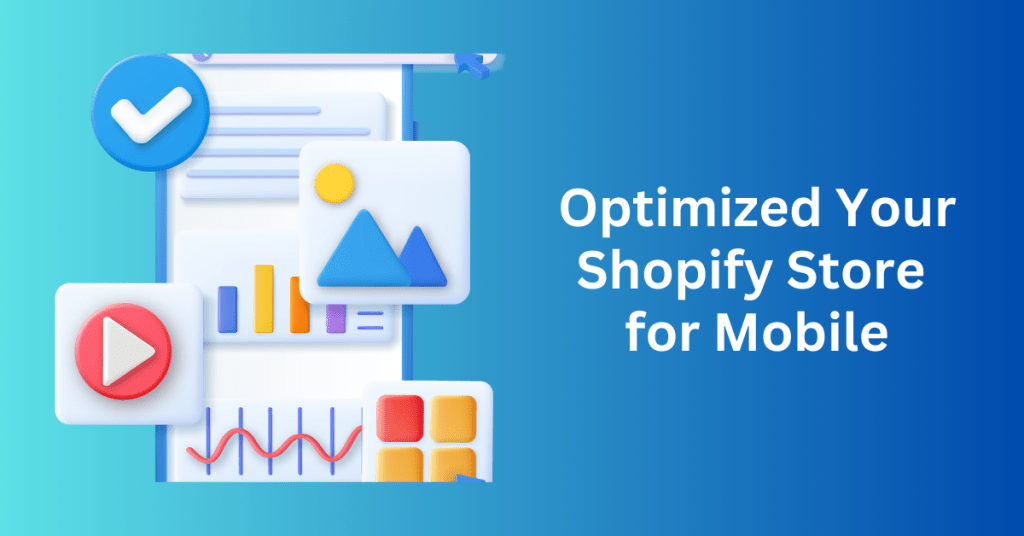
Having a Shopify store that’s not optimized for mobile devices is like having a brick-and-mortar shop with doors that only open for trucks. With an estimated 66% of shoppers in the USA making purchases on their mobile devices, mobile optimization is not just a nice-to-have but a must-have.
A mobile-friendly store guarantees accessibility for all potential customers, regardless of their device. Achieving this involves a responsive design that adapts smoothly to various screen sizes, touch-friendly navigation, and a straightforward checkout process that’s equally efficient on smartphones and desktops.
Moreover, a mobile-optimized site should load quickly, offer easy navigation, and deliver a seamless shopping experience comparable to the desktop version. Prioritizing mobile optimization expands your audience and facilitates on-the-go shopping for a broader customer base.
4. Bad Product Photo and Listings
A picture is worth a thousand words, and this is especially true in the world of online retail. When your product images are blurry, poorly lit, or too generic, they fail to capture the attention of potential customers, leading them to bypass the cart button entirely.
Consider Etsy as a prime example: a staggering 90% of buyers reported that the quality of product images was the most critical factor in their purchasing decisions. This trend is not exclusive to Etsy. Instead, it is highly likely that your Shopify store experiences the same consumer behaviour.
However, stunning visuals alone are not enough. Equally vital are the product descriptions that accompany your images. These descriptions should be thorough and captivating, emphasizing the unique benefits and features of your items. Generic phrases that provide little information won’t suffice. Instead, craft persuasive and engaging copy that helps shoppers understand the value and necessity of your product in their lives.
In essence, your product presentation serves as your virtual salesperson. It’s not just about showcasing what you sell, but convincing potential customers why they cannot live without it. Every detail, from the imagery to the text, should work together to create a compelling narrative that drives sales. Make every aspect of your product presentation count!
5. Lack of Trust and Authority
Trust is the foundation of any successful online store. When customers visit your Shopify site, they immediately seek signs that assure them they can safely do business with you. Without these trust signals, potential buyers might hesitate to proceed with a purchase, regardless of how excellent your products are.
Here are key elements that signal trustworthiness to your customers:
- Customer Reviews and Testimonials: Positive feedback from other buyers can significantly boost confidence in your products and service.
- High-Quality Website and Product Designs: A professional and visually appealing website reflects your commitment to quality and attention to detail.
- Secure Socket Layer (SSL) Certificates: SSL certificates ensure that customer data is encrypted and secure, protecting sensitive information during transactions.
- Trust Badges: Displaying trust badges from reputable organizations can reassure customers about the security and legitimacy of your site.
- Clear Return Policies: Transparent and fair return policies provide customers with the assurance that they can return products if necessary, reducing the risk associated with purchasing.
- Contact Information: Providing accessible and clear contact information shows that you are available for customer support and inquiries, building a sense of reliability.
- Social Media Presence: An active social media presence allows customers to see real-time interactions and updates, further establishing your credibility and approachability.
By integrating these elements into your Shopify store, you create a trustworthy environment that encourages customers to confidently make purchases.
6. Lengthy and Complicated Checkout Process
A complicated or lengthy checkout process can present a formidable obstacle to completing a sale. When customers encounter numerous forms, unnecessary steps, or confusing navigation, it’s akin to setting up hurdles in their path during a sprint.
Modern shoppers demand a swift, effortless, and secure checkout experience. By simplifying the process, minimizing the number of clicks required, and offering clear instructions, you can mitigate cart abandonment and enhance the probability of shoppers finalizing their purchases.
7. Limited Payment Options
Limiting payment methods to just a few options could discourage potential customers who prefer alternative payment methods. It’s crucial to understand that payment preferences can vary significantly based on geographic location, demographic factors, and individual habits.
In some regions, credit cards may be the preferred payment method, while direct bank transfers or digital wallets could be more common in others. Failing to cater to these preferences could alienate part of your audience who might otherwise have completed their purchases.
To cater to a broader customer base, it’s prudent to integrate a range of payment gateways into your Shopify store. This can encompass major credit cards, PayPal, Apple Pay, Google Pay, cryptocurrency options, and even buy now, pay later services. Offering multiple options makes it easier for customers to say “yes” to your products.
Moreover, ensure that the payment process is secure and straightforward, with clear instructions and confirmation of successful transactions. This instills confidence in your shoppers and fosters trust in your brand.
Start Your Shopify Store Today
How to increase Shopify Sales: 8 Proven Tips
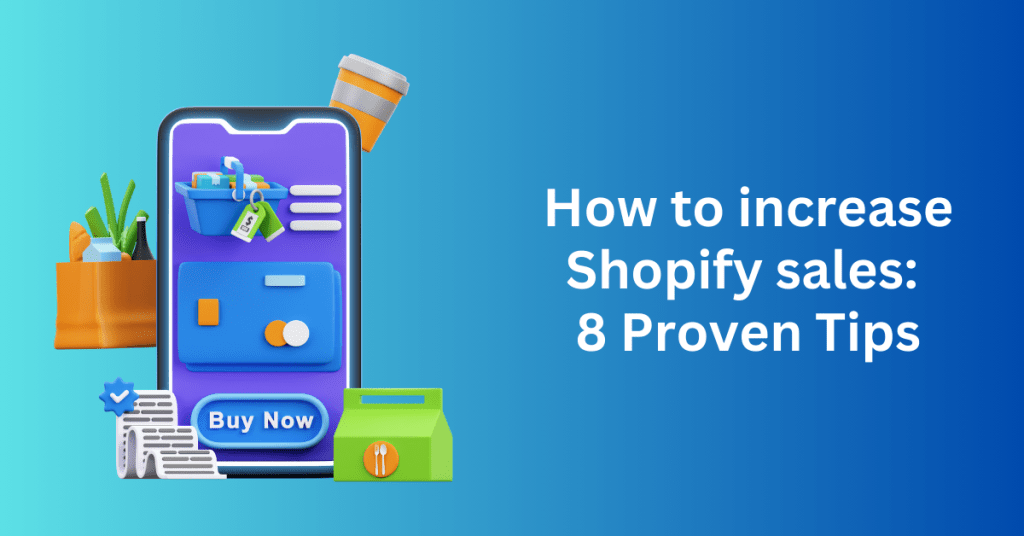
These tips represent proven strategies that top-performing stores utilize to drive revenue and foster growth. From refining your store’s layout to implementing effective outreach strategies, each tip serves as a stepping stone toward building a more successful online business. Let’s kick things off by focusing on generating traffic to your store!
1. Drive Organic Traffic with SEO to increase Shopify Sales
Search Engine Optimization (SEO) serves as a potent tool for enhancing visibility and driving organic traffic to your Shopify store. Through strategic optimization involving relevant keywords, compelling meta descriptions, and top-notch content, you can improve your rankings on search engine results pages (SERPs).

This approach is essential for capturing the attention of potential customers actively seeking products akin to yours online. Moreover, maintaining a dynamic blog with informative articles, incorporating alt tags into images, and ensuring a clear, hierarchical structure for your site will amplify your SEO.
It’s vital to recognize that the higher your store ranks in search results, the more likely users are to click through and explore your offerings. Thus, investing in robust SEO practices not only boosts visibility but also maximizes the potential for engagement and conversions. In addition, Shopify provides different apps to make your Shopify store SEO-friendly.
2. Run Paid Ads to increase Shopify Sales
Crafting a strategic advertising plan is crucial for businesses looking to attract customers and boost sales. Firstly, it begins with a comprehensive understanding of the market environment. This includes an in-depth analysis of competitors’ strategies, pricing models, and customer engagement tactics. By gaining insights into the competitive landscape, you can identify opportunities to differentiate yourself and develop a unique value proposition that sets you apart.
Furthermore, developing detailed buyer personas is essential for targeted advertising efforts. These personas represent the ideal customer demographic and psychographic characteristics, guiding content creation and ensuring that messaging resonates effectively with the target audience. By tailoring advertising efforts to specific buyer personas, businesses can enhance relevance and engagement, ultimately driving higher conversion rates.
On the other hand, selecting the right marketing channels is another critical aspect of a successful advertising plan. You should identify where your ideal customers spend the most time and focus efforts on those platforms. Engaging with customers on social media and running targeted ads can be highly effective strategies. Additionally, leveraging pay-per-click (PPC) advertising can optimize advertising spending for maximum ROI, ensuring that resources are allocated efficiently to reach the desired audience.
Hence, regular analysis of advertising campaigns is essential for ongoing optimization and improvement. By tracking key performance metrics and measuring results against business objectives, businesses can identify areas for refinement and adaptation. This continuous cycle of analysis and optimization ensures that advertising efforts remain aligned with overarching goals and objectives, driving sustained growth and success.
3. Social Media Marketing to increase Shopify Sales
Social media is always evolving, providing numerous chances for Shopify store owners to grow their brands and connect with customers. Managing social media platforms allows you to build a strong brand presence, display your products, and engage with your audience instantly.

A successful social media strategy involves several key components. These include posting consistently, using high-quality visuals, and creating interactive content that appeals to your target audience. Additionally, leveraging social media analytics enables you to monitor engagement metrics and adjust your strategy based on what resonates best with your audience.
Moreover, social media advertising presents a highly effective means of enhancing visibility and driving targeted traffic to your Shopify store. Leveraging sophisticated targeting options, you can reach potential customers based on their interests, behaviors, and demographics. Collaborating with influencers and harnessing user-generated content can further amplify your reach and bolster the credibility of your brand.
Social media platforms shouldn’t just be seen as sales channels. They’re also places for building relationships and creating a sense of community around your brand. You can achieve this by sharing informative, entertaining, and inspirational content. This helps you build a loyal following, which can boost sales on your Shopify store in the long run. By embracing social media for connecting with your audience and delivering meaningful experiences, you can pave the way for long-term success and sustained growth.
4. Build Relationship With Your Buyers with Email Marketing to increase Shopify Sales
Email marketing stands out as one of the most effective tools for connecting with customers and fostering engagement. It offers a direct line of communication with your audience, providing a platform to share updates, promotions, and personalized content tailored to their preferences.
Through well-crafted email campaigns, businesses can nurture leads, cultivate customer loyalty, and drive repeat sales. This versatile channel accommodates a range of marketing objectives. It can be used for announcing new product launches. Also, for sharing informative content. Additionally, for offer exclusive discounts to incentivize purchases.
Furthermore, with advanced analytics, businesses can measure the success of their email campaigns. They can track engagement metrics and glean insights to optimize future efforts. This leads to enhanced performance and effectiveness.
Getting started with email marketing is relatively straightforward. By incorporating a newsletter signup section directly into your Shopify store or utilizing user-friendly apps like Klaviyo or Privy, businesses can effortlessly collect customer data and orchestrate targeted campaigns that resonate with their audience’s interests and preferences. This personalized approach not only strengthens customer relationships but also boosts the likelihood of conversion and long-term brand loyalty.
5. Optimize Your Website Design to increase Shopify Sales
A captivating and intuitive website design plays a pivotal role in both attracting and retaining customers. A carefully crafted website has the power to sway purchasing decisions by offering visitors an engaging shopping journey that entices them to explore products and ultimately make a purchase.
The design of your website should be a reflection of your brand’s identity and ethos, employing a color palette and layout that seamlessly aligns with your branding. Incorporating high-quality images, legible typography, and a well-organized structure are fundamental components that contribute to a positive user experience. Furthermore, optimizing your website for usability and speed is imperative. A sluggish site can deter potential customers, leading to higher bounce rates and diminished customer retention.
In addition, it’s paramount to design with your target audience in mind. Tailoring your website interface to cater to their preferences and needs is essential. This might entail implementing features such as personalized recommendations, user-friendly search functionalities, and clear calls to action that facilitate users through the purchasing journey.
By prioritizing user-centric design principles and ensuring seamless functionality, businesses can create a website that not only captivates visitors but also fosters lasting connections with customers, driving sustained engagement and conversion rates.
6. Simplified Your Checkout Process to increase Shopify Sales
In today’s fast-paced digital landscape, shoppers have come to expect nothing less than a quick, seamless, and secure checkout experience. By simplifying the process, minimizing the number of steps, and providing clear guidance, businesses can effectively reduce cart abandonment rates and improve the likelihood of completing a purchase.
An effective strategy involves incorporating features such as one-click purchasing, which speeds up the transition from browsing to completing transactions. Moreover, providing various payment methods like digital wallets and localized options allows customers to select their preferred method, making the purchasing process smoother.
Transparency is crucial. Giving customers upfront details like shipping costs and tax calculations eliminates any last-minute surprises that might deter a sale. Studies show that unexpected extra costs are a major reason for cart abandonment, highlighting the significance of clarity during checkout.
Statistics show that the average online shopping cart abandonment rate is nearly 70%, with extra costs cited as a significant contributing factor by almost half of consumers. Therefore, prioritizing a streamlined checkout experience isn’t just about convenience; it’s about respecting the customer’s time and reducing friction at every opportunity.
A user-friendly checkout process, along with incentives like free shipping, boosts customer satisfaction and encourages repeat purchases. Prioritizing simplicity, transparency, and convenience helps businesses optimize their checkout process to meet modern shoppers’ expectations and drive higher conversions.
7. Use High-Quality Product Photos and Descriptions to increase Shopify Sales
Compelling product imagery is essential for showcasing your products effectively and building trust with potential customers. It’s vital to have crisp, clear, and high-quality photos to create a positive buying experience. Consistency in style and quality across all images is key, and using multiple angles gives customers a complete view of your products, aiding them in making informed decisions.
Equally important to stellar imagery is the refinement of product descriptions. This is where you have the opportunity to captivate and persuade your audience with words. Craft descriptions that are not only informative but also engaging and infused with personality. Rather than solely focusing on product features, highlight the benefits and advantages they offer to potential buyers.
Storytelling can be a powerful tool in connecting emotionally with customers and helping them envision how your products can enhance their lives. By weaving narratives around your products, you create a more immersive and compelling shopping experience.
Your product descriptions serve as silent salespeople, working tirelessly to persuade and compel customers to make a purchase. Invest time and effort into crafting descriptions that are persuasive, informative, and tailored to resonate with your target audience.
8. Add a Trust Badge To Your Store to increase Shopify Sales
Establishing trust with your customers is paramount to converting visitors into buyers. Trust signals serve as crucial elements in reassuring customers that your store is legitimate, secure, and customer-centric. These signals encompass various features designed to instill confidence in your brand and its offerings.
Customer testimonials and reviews serve as potent forms of social proof, demonstrating that others have not only made purchases from your store but also been satisfied with the quality of your products and the level of service you provide. Incorporating ratings and reviews prominently on your website helps to build credibility and trust among potential buyers.
Security badges, such as SSL certificates, are another vital trust signal. These badges indicate to customers that their personal and payment information is safeguarded, instilling confidence in the security of transactions conducted on your website.
In addition to social proof and security measures, providing clear and accessible contact information, comprehensive FAQs, and a transparent and fair returns policy further reinforces trust. These elements demonstrate transparency, reliability, and a commitment to providing a positive shopping experience for your customers.
Moreover, actively engaging with your community on social media platforms and maintaining an open line of communication further enhances trust. By demonstrating your accessibility and responsiveness, you reinforce the notion that you value your customers’ concerns and are dedicated to meeting their needs.
Start Your Shopify Store Today
Final Thoughts: Why Your Shopify Store is Not Getting Sales? And How To Solve It
Congratulations on reaching the end! Let’s recap the key insights we’ve uncovered:
- Define Your Target Audience: Clearly define the demographics and preferences of your target customers to tailor your marketing efforts effectively.
- Utilize Multiple Marketing Channels: Employ a combination of SEO, social media marketing, and targeted PPC ads to reach your audience cost-effectively and efficiently.
- Optimize Your Website: Create an intuitive, visually appealing website with a fast and trustworthy checkout process to enhance the user experience and build trust with customers.
- Enhance Product Presentation: Use high-quality images and compelling product descriptions to showcase your offerings effectively and entice potential buyers.
- Analyze and Optimize: Continuously analyze the performance of your advertising tactics and make adjustments as needed to improve effectiveness and maximize ROI.
By embracing these strategies, you’ll be well-positioned to see your online store flourish into a thriving hub of satisfied customers and increased sales. Keep implementing and refining these tactics, and watch as your business grows and thrives in the competitive world of ecommerce.
